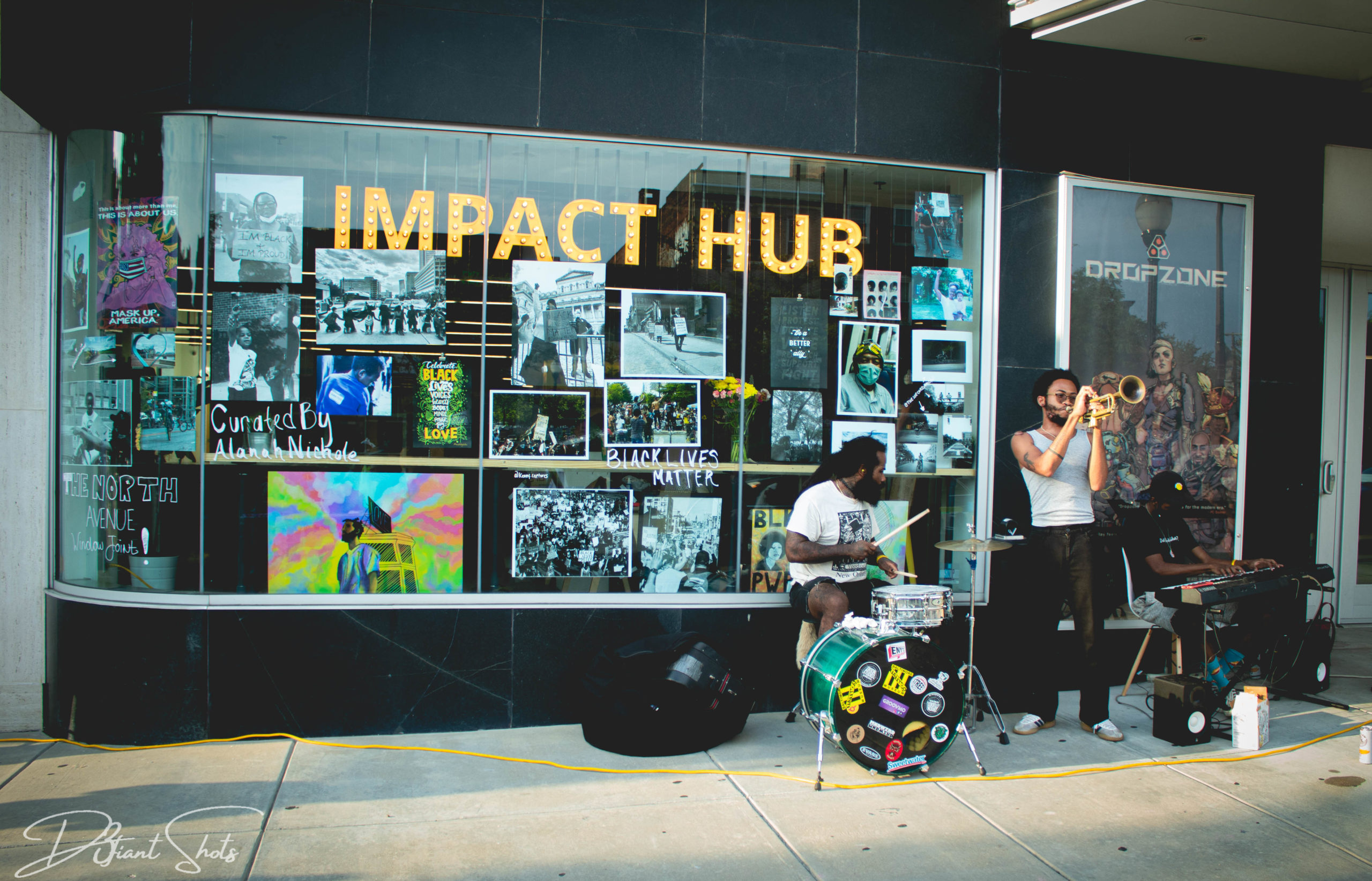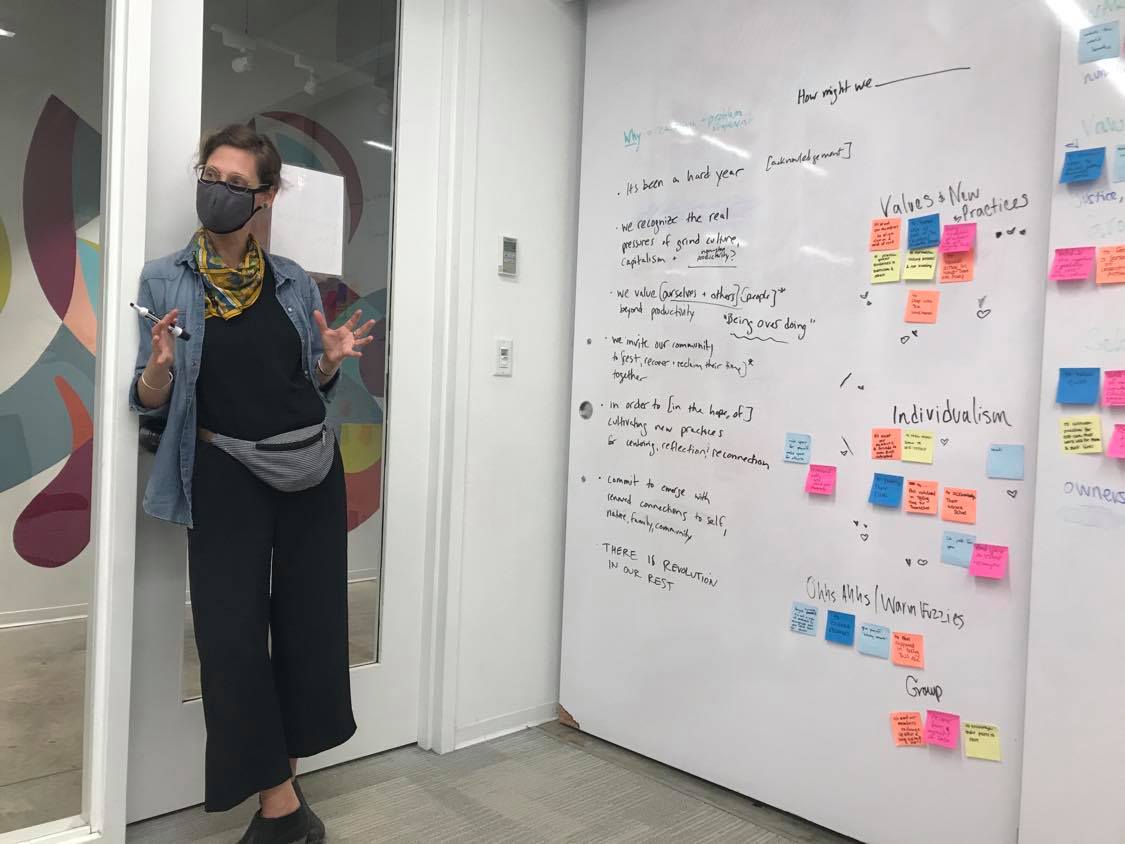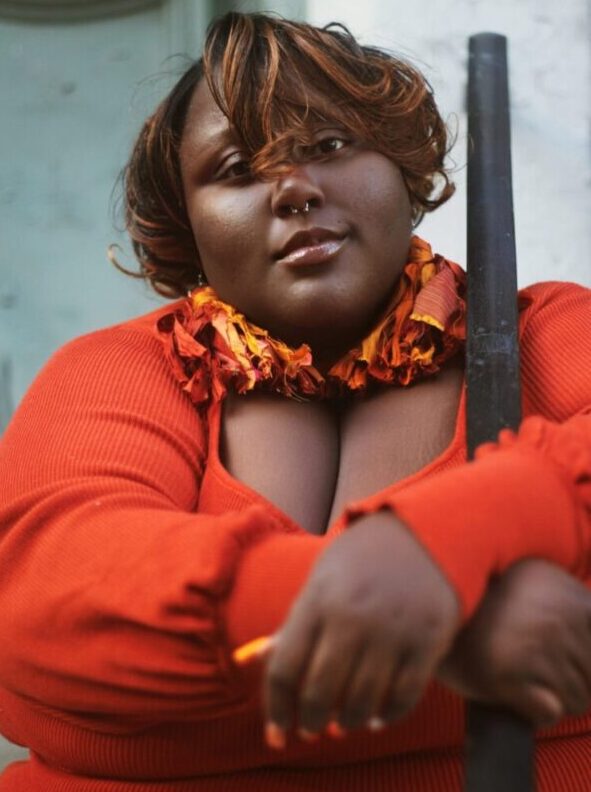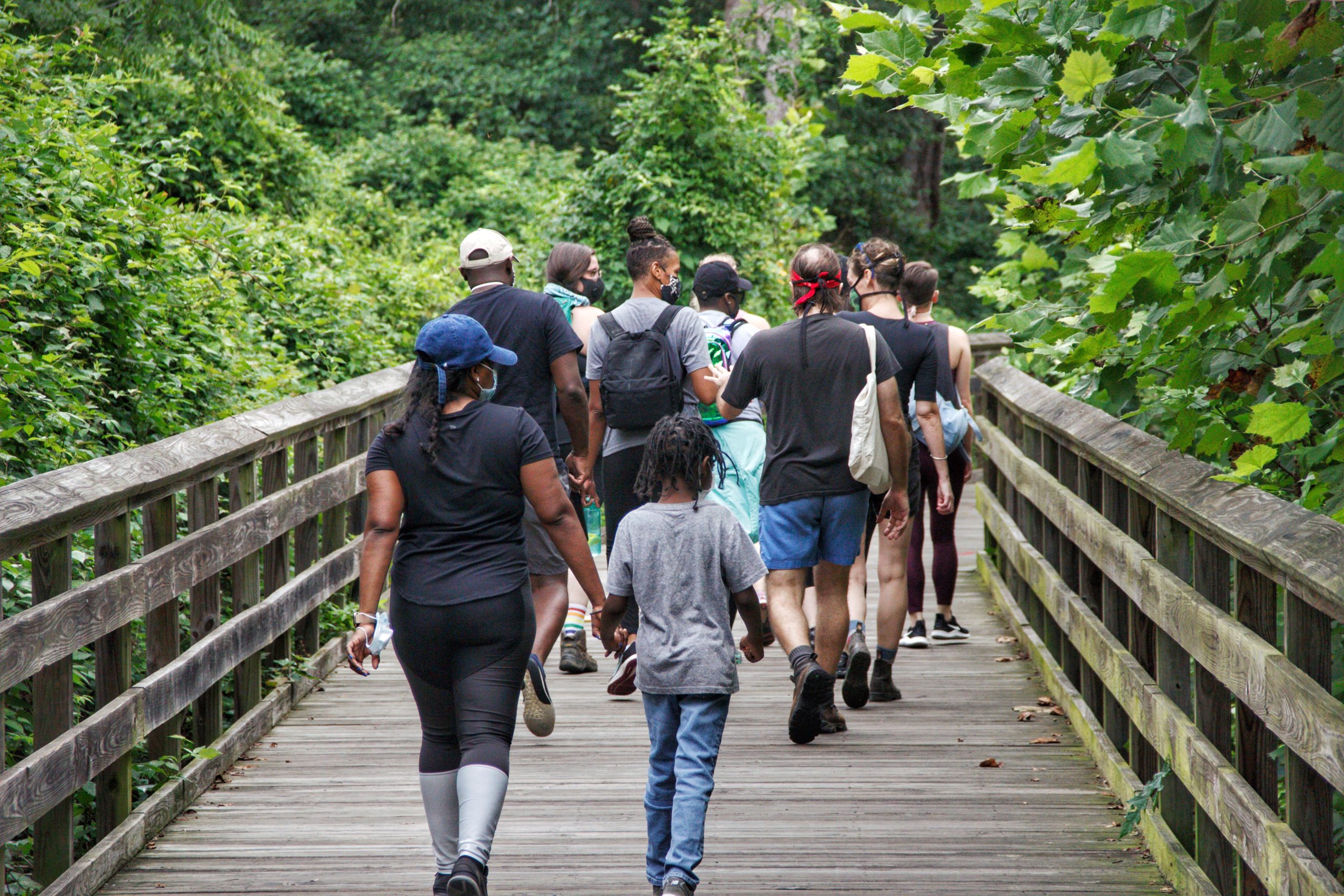Editor’s note: These last weeks of March mark one year since the COVID-19 pandemic arrived. In this guest post, Impact Hub Baltimore marketing and outreach manager Alanah Nichole Davis and executive director Michelle Geiss each take a section to share how the Station North social entrepreneurship community has approached the last year, and what they’re taking forward.
Alanah Nichole Davis: ‘Slow back down’
Oh, brother. Not again.
Those were the words I could best pair to the feeling in my soul when the calendar flipped from February 2021 to March 2021, nearly a month ago. I didn’t shudder because I don’t like Aries season, but because of the trauma I think we all have surrounding what happened in 2020 — from civil unrest due to the murder of Breonna Taylor, George Floyd and so, so many others, to the pandemic that we are still in.
While it’s a year later and a light has shone through with acts like Mayor Brandon Scott getting the Johnson and Johnson vaccine, I honestly can’t believe it’s been over 365 days since the start of what has been a triple threat of a harrowing, unprecedented and considerably life-changing time this past year.
The task of personally reflecting on the toll the pandemic has taken on my life is one better left for therapy. Siri, remind me to make a therapy appointment. So I did what anxious-but-high-performing Black women do when facing feelings better left unprocessed due to their weight: I leaned into my work. Work is measurable, work is soothing, work is always there for you to come back to — unlike our old normal of clinking glasses together with friends after in-person non-profit brainstorms, meetings and think tanks. This makes me think back, and I’ve brought a good friend, colleague, mentor, and Impact Hub Baltimore cofounder Michelle Geiss to do so with me.
Impact Hub Baltimore is located in an 8600-square-foot building along North Avenue, but it’s much more than just space. We support and connect a community of Baltimore changemakers by providing an inspiring workspace and innovative programming to scale and sustain their social impact year-round, and even did so throughout the pandemic. Together, the Impact Hub Baltimore team is building an innovative local economy that advances equity and opportunity. For this reflection, we were “pulling from a pretty deep, complex, and cloudy pool of reflection” as Geiss would say.

Alanah Nichole Davis at Impact Hub Baltimore’s front desk. (Courtesy photo)
On March 14, 2020, headlines in the local newspapers read, “First Baltimore City case of coronavirus confirmed.”
After learning that Baltimore County sussed out its first case of the destructive coronavirus three days prior, it was a moment that myself and many others, were expecting, but dreading.
I vividly remember Wednesday, March 11, of last year: The high for the day was 71 degrees in Baltimore, and conversations with my colleagues at Impact Hub Baltimore during our regular Wednesday weekly team meeting ensued on the topic of what communication to the members and friends of our space about the virus should include. Much like the conversations held in the 361 days to follow, all of our opinions on this matter of public health, safety, anxiety, and fear of the unknown varied.
By March 13 of last year, we had all co-authored a well thought out and well-meaning statement saying: “Acknowledging that the important work people do in our space every day contributes to the health and wellbeing of our city over the long-term. For the time being, our coworking operations will continue so that the entrepreneurs and grassroots organizations can continue to operate and advance their missions.”
It’s a decision we collectively made, and one that I was admittedly afraid about then. The uncertainty of the damage the virus could do to a community of people in the Hub and beyond — one that I know, love, trust and don’t want to see harmed — was overwhelming.
Everyone in our state and countless others were facing similar levels of uncertainty, making decisions on a day-to-day and week-by-week basis, and not knowing we were in it for quite the long haul. In that first cluster of days where news broke of COVID-19 entering the city, even Baltimore City Public Schools issued a statement, under the direction of the Maryland State Department of Education, that the district would close all of its campuses from March 16, 2020, to March 27, 2020.
As a mother of two, I was relieved. I thought that perhaps, within those two weeks, a seed of faith would be sewn into how we’d contain and respond to the rapidly growing pandemic. My fellow crew mates at Impact Hub Baltimore even followed suit, thinking and processing in smaller two-week frames, and issuing a statement about going unhosted for the same days as city schools. By the first day of our physical closure on March 16, in an effort to quell the spread of the virus, we had a Live COVID-19 Resource Listing up and running for small businesses, nonprofits and creatives.
While we so badly wanted to return to the bustling normal of a coworking space built to foster collaboration, we couldn’t and didn’t until Baltimore City entered the second phase of reopening. We began to survey our members, hold town halls and collect data about comfortability in returning to our space on North Avenue in June, and I began to print signage for a new, physically distant seating plan in July for reopening.
It was a far cry from the initial two-week closure in March.
In the stead of our traditional in-person and shoulder-to-shoulder method of bringing together entrepreneurs, innovators, creatives, and professionals to drive the positive change often needed in Baltimore we shifted to virtual skill shares, we shared hikes led by community managerSam Novak, member stories on a new Impact Hub Baltimore-centric Medium page created by Irene Bantigue to highlight the perspectives of our cities doers, thinkers, and dreamers and this guest post about the Baltimore school system published in August.
In my gut, I hardly wanted to move, as many of us didn’t. Our team somehow led 60+ engagements and programs in 2020, reaching 1,500+ participants. In the first months of the COVID-19 shutdown, our engagement efforts focused on virtual skillshares, community lunches, and panels with SOCAP and Baltimore Innovation Week. I even ended up curating a sidewalk art opening called North Avenue Window Joint, where a handful of Baltimore-based artists and their works inspired by the civil unrest and pandemic were featured in the Impact Hub Baltimore window.

Opening The North Avenue Window Joint. (photo by Cynphany Brown and Kiwauna Selden)
This whole year has felt like a volatile art show, which I’m looking at through a window. There hasn’t been soothing jazz playing like there was that night that The North Avenue Window Joint opened, either. It’s been a much more complex score playing in the backdrop of the pandemic. I’m glad we’re all still here, clicking around the internet, trying to find ways to relate to one another in all this.
While the last year brought a lot of loss, it slowed things down and allowed for the emergence of passion, focus, and drive to burst through from a lot of people, myself included, that would otherwise be inundated with the oftentimes too-fast pace of the old normal we lived in. As 2021 proceeds, it feels like we are creeping back toward that pace. If I could uplift any advice at all, it would be to slow back down.
We can only hope we’ll never see another couple of weeks like last March in this lifetime. It was a time filled with uncertainty and confusion. But if we have to, shouldn’t we be rested? I was excited to contribute to a collaborative Rest Fest Guide with my Impact Hub Baltimore teammates, and feel I’ll be looking back at it often as we journey into 2021, and what it might hold for us.
Michelle Geiss: ‘Our systems should care more.’
There have been huge demands to adapt over this past year. Our physical operations at Impact Hub Baltimore all but ceased during the shutdown in March and have evolved continuously since reopening in July. Our team has taken on new roles to manage coworking operations while evolving policies and practices to ensure safety, and reimagining programming to bring community building and learning online or into the outdoors. Physical space shrunk in its contributions to our survival as an organization and in its functionality for our community. It has forced us to plug gaps. It has forced new thinking about how we engage with our work.
In 2020, our team stepped into new types of technical assistance and business supports in response to the pandemic. We reached people through phone lines, Zoom rooms, Google docs, inboxes, and outdoor gatherings —any way we could conjure up to tune into our community’s needs and offer up support.
Our commitment to working in coordination with the larger ecosystem enabled our team and our partners to contribute our strengths, expand total system capacity, and maximize information flow and support to small businesses. I felt proud to create trusted onramps to grants and loans with the Baltimore Development Corporation and other technical assistance partners, frustrated to respond to fiscal hosting failures with dozens of grassroots leaders and grateful to find advice and alignment with peer organizations who support social and creative entrepreneurs.
A blogger asked me on March 13, 2020, how we would build community when we couldn’t be together. My knee-jerk response was “we won’t.” My more thoughtful response was that we would struggle to build community online and that we would miss being together far more than anyone would ever predict. I thought we were staring down two months, at the most.

Impact Hub Executive Director Michelle Geiss leads a design thinking session. (Courtesy photo)
Over the year that ensued, we did bend and contort ourselves to stay in touch, but we also never lost sight of our commitment to reach people beyond the four walls of our physical space. No matter the distance, we still had the tremendous assets of our talented team, our trusted relationships, and our reputation as an advocate for small-scale, early-stage, and under-invested leaders in the city. We drew on all of these assets to shape and steer our response to the layered crises of 2020.
It’s March 2021, a year later. I’ve been spending the past few days trying to make sense of the past year, and my brain short circuits into something that looks like, “Wow what a _____ year.” That blank gets filled in with a mountain of adjectives, ranging from optimistic, sunny, lesson-rich words that fill me with pride for getting through this thing together, to dark, heavy, profanity-laced words that mirror the deep troughs of the year. It’s hard to sum it all up in a short space. There were days where our work felt like heroic acts, small and large. And days where I lost track of time and space and drowned my brain with headlines and fears about the future. And everything in between.
Looking back, I feel like the greatest triumph was just getting through it intact and managing to keep a small team of amazing people employed and afloat. If we could extend that intactness outwards to buoy the people around us or leverage our position in the system to direct policy and resource flow to people who needed them most, those were our heroic moments. We did plenty of that, and I am proud of that impact. In the same breath, I have to acknowledge that it is never enough. The grief and loss and pain inflicted by this crisis were too immense for a tiny team to make a big dent. Our gold standard was to hold people close, keep checking in, and do what we could.
I feel fortunate to have been in a position to be useful to the world. Selfishly, I feel like being productive was protective. We had people to lean on, we had platforms to speak on, and we had the collective capacity to adapt. I gained a new respect for what the entrepreneurs in our community can do in the face of crisis. And I was humbled by having a front-row seat to witness their tenacity and genius. At the same time, it breaks my heart to watch a system fall apart at the seams and rely on the sheer will of fragile and fallible humans to figure it out. It shouldn’t have to work that way. Our safety nets should be stronger than that. Our systems should care more.
Our gold standard was to hold people close, keep checking in, and do what we could.
This past year revealed exactly where our society is vulnerable. Every single relief effort tells a story. Every dollar that needed to be deployed reflected someone who was generating all of that strength on their very own before this crisis hit. The artists, small business owners, parents, teachers, frontline workers, and community leaders who needed an extra boost this past year generate whole economies and social structures that many of us take for granted during “normal times”. They are the perennial providers of mutual aid. They anchor our communities and make them vibrant places to live, work, and play. And they provide these services with hardly a “thank you” and very little outside support. We witnessed countless people fight like hell to keep themselves and their loved ones afloat.
As we re-emerge from this crisis and construct our future together, I hope that we will honor this work and do a better job supporting it. I want us to take a close look at our social contract with one another and understand how interconnected we truly are. And I want us to translate that understanding into policies and resources that honor the invisible economies all around us.
We can address centuries of structural inequities. We can build economies that generate life, dignity, and self-determination. We can create new patterns of care, resource flow, and accountability. We can learn from this year and make new choices.
As we re-emerge in 2021 and make sense of everything we’ve been through, I want us to hold the complexities of 2020, be honest with ourselves about what needs to change, and step boldly into creating a future that looks dramatically different than the past.
Before you go...
Please consider supporting Technical.ly to keep our independent journalism strong. Unlike most business-focused media outlets, we don’t have a paywall. Instead, we count on your personal and organizational support.
Join our growing Slack community
Join 5,000 tech professionals and entrepreneurs in our community Slack today!

The person charged in the UnitedHealthcare CEO shooting had a ton of tech connections

From rejection to innovation: How I built a tool to beat AI hiring algorithms at their own game

Where are the country’s most vibrant tech and startup communities?


